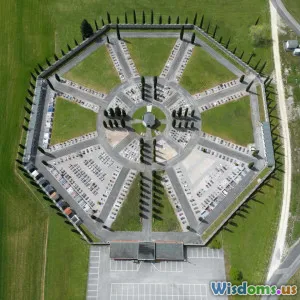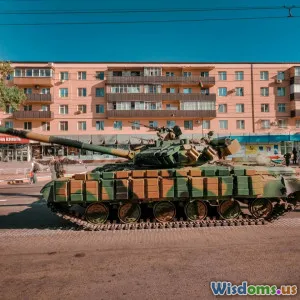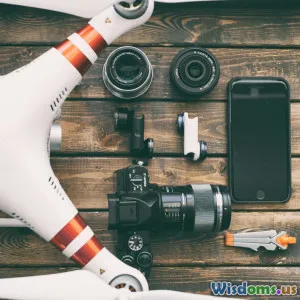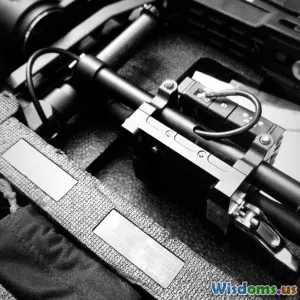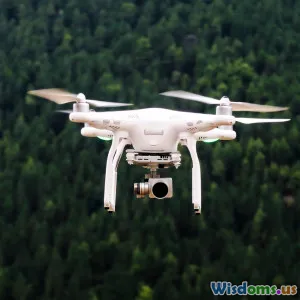
The Surprising Costs Behind Military Drone Maintenance
16 min read Discover the hidden complexities and financial realities involved in military drone maintenance, revealing the true cost beyond acquisition. (0 Reviews)
The Surprising Costs Behind Military Drone Maintenance
Introduction: Drones’ Hidden Price Tag
When we imagine military drones, visions of soaring UAVs (unmanned aerial vehicles) gathering intelligence, tracking movement across enemy lines, or executing precision airstrikes quickly come to mind. Their reputation for surgical accuracy and low-risk deployment reinforces an image of technological efficiency. But seldom is attention paid to what keeps these machines in the air—their ongoing, often staggering maintenance costs.
The dollar amount the Pentagon spends to acquire drones makes headlines, yet what rarely registers with the public (or policymakers) is the enormous, multi-layered expense required to maintain, service, and upgrade these fleets. Maintenance costs for drones like the MQ-9 Reaper or advanced systems like the RQ-4 Global Hawk can rival, or in some cases surpass, their acquisition cost over their operational lifespan. So what goes into keeping these 'eyes in the sky’ aloft, and why is it so costly? Let’s dive in.
Unmasking Military Drone Maintenance: It’s More Than Just Fixing Parts
Maintaining a military drone fleet isn’t as simple as swapping out worn rotors or tightening bolts. It’s a multi-dimensional endeavor involving advanced electronics, regular software updates, complex supply chains, tightly-scripted maintenance routines, and a highly trained workforce.
The True Cost of Readiness
A drone’s sticker price is only the beginning. The U.S. Department of Defense estimates that 60 to 70 percent of a drone’s life-cycle cost is devoured after the initial purchase, with maintenance taking the lion’s share. Even conservative estimates peg the annual maintenance cost of drones like the MQ-9 Reaper at $3.8 million per unit per year. The RQ-4 Global Hawk’s perceived “low maintenance” strategy was upended when the Air Force revealed that just to fly and sustain a single unit topped $13,000 per flight hour—fuel is a fraction, while labor, spare parts, and advanced troubleshooting eat up the rest (source).
Why Drones Demand More Than Airplanes
Contrary to expectations, maintaining a modern drone is just as, if not more, demanding than a conventional piloted aircraft. UAVs are packed with state-of-the-art sensors, highly sensitive flight controls, encryption gear, sophisticated weather monitoring apparatus, and classified payloads. These require precise calibration and are prone to the same wear and tear as any other flight component—sometimes more frequently, given the intense pace of military operations deployed. Reaper drones supporting operations in the Middle East, for example, routinely saw usage rates double, compared to peacetime standards, accelerating the need for inspections, part replacements, and overhauls.
The Building Blocks of Drone Maintenance Costs
Drone maintenance involves much more than spare parts. Let’s unpack the biggest contributors:
1. Skilled Personnel: The Human Price of High-Tech Warfare
Even unmanned systems need an army of highly trained humans. UAV maintenance mechanics must understand aeronautics, electronics, cybersecurity, and sometimes classified systems. Training isn’t quick or cheap—a technician qualified to work on the RQ-4, for instance, undergoes months of specialized instruction and security clearance, costing upwards of $100,000 per individual.
And it doesn’t end with up-front education. Tech is always changing. With every software update, maintainers must re-certify or train on new procedures, costing time and money. The Air Force, in a 2022 study, highlighted that nearly 20% of Reaper maintenance hours were spent on learning or adapting to new technology introduced through mandatory upgrades.
Real-World Example: Maintaining Readiness
At Creech Air Force Base, home of the MQ-9, multiple technicians are sometimes required for basic diagnostics due to increasing hardware-software integration. “An overnight update can result in three days of maintenance backlog if things go wrong,” one Airman told Defense News—a small problem in software can bring an entire squadron’s operational status to a halt.
2. Parts, Repairs, and Supply Chain Snafus
Acquiring a replacement landing gear for a manned plane might involve well-established, often commercial supply channels. Not so with high-end military drones. Proprietary, sometimes classified, and manufactured by only a handful of suppliers, drone components are costlier and slower to source. A single spare radar for the Global Hawk can exceed $1 million. Lead times stretch into months; if a drone goes down, its flight group can suffer resource gaps for extended periods.
The Impact of the Microchip Crunch
Drones’ reliance on specialized electronic parts means global events—like the 2021 microchip shortage—ripple through drone sustainment budgets. The Pentagon admitted some Global Hawk service interruptions in 2021 were directly due to delays in sourcing key electronics (source). Maintenance can become a waiting game.
3. The Heavyweight of Software Destabilization
Modern drones are flying computers. Cybersecurity requirements mean the Department of Defense, alongside manufacturers, pushes out regular software patches—sometimes monthly. These updates must be thoroughly tested on each airframe, often requiring operational pauses and technician oversight. In 2022, 14% of all maintenance downtime for Reapers tracked by the USAF was related not to hardware failure, but to digital troubleshooting after routine software updates.
A Quote from the Field
“A glitch in the UAV’s mission software can ground the aircraft just as surely as a broken wing,” says Capt. Tom P—an Air Force drone maintenance officer. “Every software update carries risk—we’ve seen new vulnerabilities or logic conflicts cause days of operational downtime.”
4. Environmental Wear and Tear: Combat Use Isn’t Peacetime Use
UAVs deployed to dusty, hot, or sandy locations (such as Afghanistan or North Africa) see exponentially higher rates of maintenance events. Sand infiltration can destroy sensors and intake fans. Electronics suffer more frequent outages. Between 2018 and 2020, drones deployed in Southwest Asia experienced double the electronics-related failures compared to those stateside, according to an Air Combat Command maintenance review.
5. Infrastructure, Tools, and Testing
Maintenance costs go well beyond individual aircraft—drone hangars often require climate control, specialized power supplies, and highly protected workshops to handle classified equipment. Network hardening to prevent cyber intrusions can add millions to base infrastructure budgets. As drone fleets grow, so does the need for remote diagnostic equipment and encrypted networking tools to reduce time spent on preventative maintenance.
“Maintaining a secure, climate-controlled hangar for drones with sensitive sensors can cost as much annually as the medical facility on a small base.” —Base Infrastructure Analyst, GAO
Big Data and the Drone Gold Rush: Predictive Maintenance Isn’t Cheap
Embracing Predictive Analytics—at a Price
Traditional maintenance is reactive—wait for something to break. Today’s military, however, is investing heavily in predictive maintenance for drones, using big data and AI to forecast failures before they occur. This involves attaching extra diagnostic sensors, uploading logs after every flight, and hiring new teams of data analysts. Initial investment in big data upgrades for the Air Force’s drone fleet topped $200 million over three years.
The goal? Catch issues early, save money, and keep more drones mission-ready. But in practice, the costs are front-loaded and require constant recalibration: as new problems and drone models arrive, so do new expenses. The Air Force has cited a 25% reduction in unscheduled MQ-9 maintenance events using predictive maintenance since 2020—but the implementation cost $60 million for just one control squadron with 18 drones.
Data Security: The Next Hidden Bill
With greater digital diagnostic capability comes higher cybersecurity risk. Keeping maintenance data secure (and systems hack-free) is an ongoing challenge—requiring continuous investment in encryption and intelligence-grade communication networks, which add another layer to already complex cost calculations.
International Partners and the Hidden Labor of Exported Drones
The U.S. isn’t the only country managing ballooning drone maintenance budgets. Allies like the UK and Germany, having purchased Reaper and Heron drones respectively, found the back-end costs so unpredictable that groundings became commonplace. In 2018, for instance, the UK had only two of its ten Reapers airworthy due to maintenance backlogs and parts scarcity.
Emerging drone operators tend to overlook training, logistics, and infrastructure expenses until well after acquisition. Some have faced multi-million-dollar cost overruns or even had drones lose operational status due to lack of specialized sustainment contracts or the inability to secure sensitive spare parts subject to export restrictions.
Lifecycle Extension: Modernization vs. Replacement
Every military drone fleet faces the tough decision: how to extend service life. Should they:
- Invest in periodic self-funded upgrades (e.g., better sensors, new communication links)
- Sign long-term service agreements with OEMs (Original Equipment Manufacturers—costly, yet reliable)
- Or begin the costly process of replacing entire fleets?
These choices aren’t just engineering challenges—they’re multibillion-dollar questions. The Air Force, for example, is currently weighing the decision of investing almost $4 billion to extend and modernize its E-11 BACN drone fleet versus phasing them out in the next five years.
Crashes, Accidents, and Unplanned Repairs
While accidents can ground any aircraft, drones are particularly susceptible to runway overruns, hard landings, or mid-mission malfunctions—often leading to expensive unplanned repairs. In 2016, the Pentagon acknowledged that UAVs accounted for 56% of Air Force “Class A mishaps” (incidents causing at least $2 million in damage). Investigations are costly themselves—sometimes several times the replacement cost of commercial airframes due to forensic work, sensor data analysis, and report writing requirements.
Balancing Operational Tempo and Maintenance Burden
Modern warfare depends on persistent surveillance, which increases the operational tempo for drone squadrons. This high pace exacerbates maintenance demand:
- More flight hours = faster wear & tear
- Less time available for preventative checks
The US Air Force, contending with heavy drone workloads in the Middle East, has cycled certain Reaper squadrons at double their scheduled sortie rates, only to see maintenance backlogs pile up—nearly grounding 40% of some wings in 2017, reports the Government Accountability Office.
Looking to the Future: Lowering the Maintenance Mountain
Modular Drones and Open Architecture
Realizing the burden of bespoke systems, operators are championing modularity—using interchangeable parts across different drone types—and open software. The USAF’s new Skyborg project, aiming for swappable ‘drone brains’ and plug-and-play mission modules, could significantly slash maintenance cost and downtime by simplifying training, supply, and troubleshooting.
Commercial Partnerships
The military is increasingly turning to civilian partnerships for everything from basic maintenance to logistics optimization. Contracting out non-classified repair work has helped sustain operations in remote bases.
Green Technology and Durable Materials
Material science is also playing a role: carbon composites, easier-to-clean sensors, and anti-fouling coatings are designed to thrive in the extreme climates where drones most often fail. While initial investments are high, the reduction in severity and frequency of certain failures could pay off handsomely over the drone’s lifetime.
Conclusion: The Sky-High Commitment of Keeping Drones Aloft
From early morning checks in dust-swept hangars to late-night code diagnostics halfway around the world, the work behind maintaining military drones is as demanding as it is expensive. The cost of purchasing a UAV is merely the ticket for entry; the true bill arrives each year from the ceaseless attention required to keep these sophisticated machines airborne, versatile, and secure from threats both mechanical and digital.
Stakeholders—military leaders, policymakers, and taxpayers—must reckon with the reality that every drone in the sky is backed by a vast, complex, and costly support system on the ground. Recognizing the scale of these maintenance challenges will prove essential as nations recalibrate their defense budgets and balance military innovation with lasting affordability. The story of military drones is not just one of technological triumph, but also a testament to the hidden, enduring costs of modern warfare.
Rate the Post
User Reviews
Popular Posts












